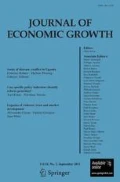Abstract
In this paper, we develop a model of technology adoption and economic growth in which households optimally obtain either a concept-based, “general” education or a skill-specific, “vocational” education. General education is costly to obtain, but enables workers to operate new production technologies. Firms weigh the cost of adopting and operating new technologies against increased profits and optimally choose the level of adoption. We show that an economy whose policies favor vocational education will grow slower in equilibrium than one that favors general education. More importantly, the gap between their growth rates will increase with the growth rate of available technology. By characterizing the optimal Ramsey education policy we also demonstrate that the optimal subsidy for general education increases with the growth rate of available technology. Our theory suggests that European education policies that favored specialized, vocational education might have worked well, both in terms of growth rates and welfare, during the 1960s and 1970s when available technologies changed slowly. However, in the information age of the 1980s and 1990s when new technologies emerged at a more rapid pace, they might have contributed to an increased growth gap relative to the United States.
Similar content being viewed by others
References
Acemoglu, D. (1998). “Why Do New Technologies Complement Skills? Directed Technical Change and Wage Inequality,” Quarterly Journal of Economics 113(4), 1055-1089.
Allen, R. C. (1998). “The Employability of University Graduates in the Humanities, Social Sciences, and Education: Recent Statistical Evidence,” Discussion Paper No.: 98-15, Department of Economics, The University of British Columbia.
Atkeson, A., and P. J. Kehoe. (2001). “The Transition to a New Economy After the Second Industrial Revolution,” Federal Reserve Bank of Minneapolis Research Department Staff Report.
Bartel, A. P., and F. R. Lichtenberg. (1987). “The Comparative Advantage of Educated Workers in Implementing New Technology,” The Review of Economics and Statistics LXIX, 1-11.
Bartel, A. P., and F. R. Lichtenberg. (1991). “The Age of Technology and its Impact on Employee Wages,” Economic Innovation and New Technology 1, 215-231.
Benhabib, J., and M. M. Spiegel. (1994). “The role of human capital in economic development: Evidence from aggregate cross-country data,” Journal of Monetary Economics 34, 143-173.
Bessen, J. (2002). “Technology Adoption Costs and Productivity Growth: The Transition to Information Technology,” Review of Economic Dynamics 5(2), 443-469.
CERGE-EL (1997). Czech Republic 1997: The Year of Crises.
Cummings, J., and G. Violante. (2002). “Investment-Specific Technical Change in the US (1947–2000): Measurement and Macroeconomic Consequences,” Review of Economic Dynamics 5(2), 243-284.
Galor, O., and O. Moav. (2000). “Ability-Biased Technological Transition, Wage Inequality, and Economic Growth,” Quarterly Journal of Economics 115(2), 469-497.
Galor, O., and D. Tsiddon. (1997). “Technological Progress, Mobility, and Economic Growth,” The American Economic Review 87(3), 363-382.
Gill, I. (1988). “Technological Change, Education and Obsolescence of Human Capital: Some Evidence for the US,” Ph.D. thesis, The University of Chicago.
Gottschalk, P., and T. Smeeding. (1997). “Cross-National Comparisons of Earnings and Income Inequality,” Journal of Economic Literature 35(2), 633-687.
Gordon, R. J. (2000). “Does the ‘New Economy’ Measure up to the Great Inventions of the Past?” The Journal of Economic Perspectives 14(4), 49-74.
Gould, E. D., O. Moav, and B. A. Weinberg. (2000). “Precautionary Demand for Education, Inequality, and Technological Progress,” Journal of Economic Growth 6(4), 285-315.
Greenwood, J., and M. Yorukoglu. (1997). “1974,” Carnegie-Rochester Conference Series on Public Policy 46, 49-95.
Hornstein, A., and P. Krusell. (1996). “Can Technology Improvements Cause Productivity Slowdowns?” NBER Macroeconomics Annual 209-259.
Kortum, S., and J. Lerner. (1998). “Stronger Protection or Technological Revolution: What is Behind the Recent Surge in Patenting?” Carnegie-Rochester Conference Series on Public Policy 48, 247-304.
Krueger, D., and K. B. Kumar. (2004). “US-Europe differences in technology-driven growth: quantifying the role of education,” Journal of Monetary Economics 51, 161-190.
Krusell, P., L. Ohanian, J.-V. Rios-Rull, and G. L. Violante. (2000). “Capital Skill Complementarity and Inequality: A Macroeconomic Analysis,” Econometrica LXVIII, 1029-1054.
Lawrence, R. Z., and C. L. Schultze. (1987). “Overview.” In R. Z. Lawrence and C. L. Schultze (eds), Barriers to European Growth: A Transatlantic View. Washington, DC: The Brookings Institution.
Lazear, E. P. (2002). “Entrepreneurship,” NBER Working Paper 9109, August.
Levesque, K. et al. (2000). “Vocational Education in the United States: Toward the Year 2000,” National Center for Education Statistics, February.
Ljungqvist, L., and T. J. Sargent. (1998). “The European Unemployment Dilemma,” Journal of Political Economy 106(3), 514-550.
Merdich, E. A., S. A. Kagehiro, and J. Houser. (1994). “Vocational Education in G-7 Countries: Profiles and Data,” National Center for Education Statistics, Research and Development Report, August.
Murphy, K. M., A. Schleifer, and R. W. Vishny. (1991). “The Allocation of Talent: Implications for Growth,” Quarterly Journal of Economics May, 503-530.
Nelson, R. R., and E. S. Phelps. (1966). “Investment in Humans, Technological Diffusion, and Economic Growth,” The American Economic Review May, 69-75.
OECD. (1977a). Education at a Glance: OECD Indicators 1997. OECD: Paris, France.
OECD. (2001). Education at a Glance: OECD Indicators 2001. OECD: Paris, France.
OECD. (1997b). Education Policy Analysis 1997. OECD: Paris, France.
Scarpetta, S. et al. (2000). “Economic Growth in the OECD Area: Recent Trends at the Aggregate and Sectoral Level,” OECD Working Paper 248.
Schreyer, P. (2000). “The Contribution of Information and Communication Technology to Output Growth: A Study of the G7 Countries,” OECD STI Working Paper 2000/2.
Stiroh, K. J. (2002). “Information Technology and the US Productivity Revival: What Do the Industry Data Say?” American Economic Review 92(5).
Violante, G. L. (2002). “Technological Acceleration, Skill Transferability, and the Rise in Residual Inequality,” Quarterly Journal of Economics CXVII, 297-338.
Welch, F. (1970). “Education in Production,” Journal of Political Economy 78(1), 35-59.
Young, A. (1993). “Invention and Bounded Learning by Doing,” Journal of Political Economy 101(3), 443-472.
Author information
Authors and Affiliations
Rights and permissions
About this article
Cite this article
Krueger, D., Kumar, K.B. Skill-Specific rather than General Education: A Reason for US–Europe Growth Differences?. Journal of Economic Growth 9, 167–207 (2004). https://doi.org/10.1023/B:JOEG.0000031426.09886.bd
Issue Date:
DOI: https://doi.org/10.1023/B:JOEG.0000031426.09886.bd




